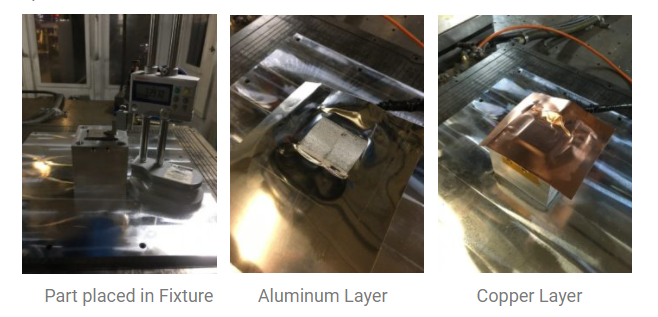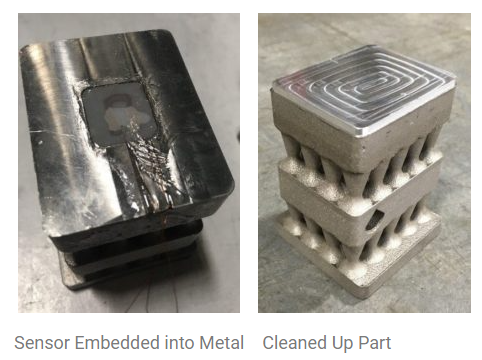Ohio-based company Fabrisonic developed a unique Ultrasonic Additive Manufacturing (UAM) process, which uses ultrasonic sound waves to merge layers of metal foil together in a solid-state. Its hybrid 3D printing process is mounted on traditional CNC equipment so that, once the layers are merged, the machine and cut out the final shape. Its UAM process is well-known for its ability to create unique features and complex internal geometries, in addition to embedding sensors into solid metal parts and combining dissimilar metals. Now, Fabrisonic is taking things even further by combining these three features and then adding in organic geometry created through metal powder bed fusion (PBF) printing.
According to SmarTech Analysis, about its “Additive Manufacturing with Metal Powders 2020” report, powder bed fusion technologies are ” penetrating the perimeters of true manufacturing, and this initial acceptance has only raised the collective bar forperformance and capability of the technologies.” In the PBF process, a layer of metal powder is deposited over a build plate, and something, most often a laser, then melts out a cross-section of the material, before new powder is added layer by layer until the part is completed.
While Fabrisonic’s UAM technology is a good choice when it comes to printing large components with, as mentioned earlier, complex internal structures, embedded sensors, and multiple metals, it’s not great for fine organic structures, due to the large forces that are necessary for creating a bond. On the flip side, while PBF is able to print organic, delicate patterns, large parts are not its strength. So, Fabrisonic combined the two in order to achieve the best possible part.
The unnamed Fabrisonic customer wanted three things for this particular project: organic stainless steel geometry, dissimilar metal transition, and embedded sensors that were completely encapsulated in metal. Fabrisonic saw that by combining PBF and UAM, it would be able to achieve the necessary organic patterns that could be embedded into large metal structures, and give the customer exactly what they wanted. The PBF components were sent to Fabrisonic as rough blanks, which were then put into a fixture so they could be constrained for welding—a necessary step to keep the substrate from moving during the vibrations that the UAM process causes. The company partnered with EWI to make the base structure for the component.
“Most fusion-based AM processes would have trouble printing dissimilar metals on a powder bed part,” Fabrisonic President Mark Norfolk wrote in a post. “However, UAM is different as it can accommodate a wide array of external conditions. If there is a smooth, metal substrate then UAM can be used.”
UAM’s subtractive technology was used to mill the top of the organic PBF printed part to an even, flat surface, and then layers of copper sheet and aluminum were printed on top.
Once Fabrisonic had printed the dissimilar metals to the correct height, it milled the part to make a pocket for the custom sensor. Once the sensor was inside, UAM was used again to print more layers of copper and aluminum over the pocket to envelop it, and a hermetic seal, created by these extra layers bonding to the existing metal, enhances the life of and protected the sensor, so that it would give more accurate readings. Finally, Fabrisonic milled all of the extra foil into the final shape.
“The part and process shown were the first of many to include both UAM and an alternative form of AM,” Norfolk concluded. “As Fabrisonic receives more opportunities to incorporate this unique technology into new applications, the products manufactured will only continue to advance. By combining the benefits of other forms of additive with the numerous benefits of UAM, different processes will begin to complement each other. Who knows what boundaries engineers and designers will push next?”
(Images: Fabrisonic unless otherwise noted)
Subscribe to Our Email Newsletter
Stay up-to-date on all the latest news from the 3D printing industry and receive information and offers from third party vendors.
Print Services
Upload your 3D Models and get them printed quickly and efficiently.
You May Also Like
Nikon SLM Solutions Sells SLM 500 to Primary Weapon Systems to Expand Suppressor Production
Primary Weapons Systems (PWS) is a Boise, Idaho-based manufacturer of suppressors, firearms, and related components. A subsidiary of Vigilant Gear and a sister company to aftermarket Glock slide manufacturer Lone...
3DPOD 261: Tooling and Cooling for AM with Jason Murphy, NXC MFG
Jason Murphy´s NXC MFG (Next Chapter Manufacturing) is not a generalist service; instead, the company specializes in making tooling. Using LPBF and binder jet, the company produces some of the...
HP and Firestorm Labs Form Partnership to Use Multi Jet Fusion 3D Printers in Deployable Factories
HP Inc., maker of a range of additive manufacturing (AM) solutions including the Multi Jet Fusion (MJF) ecosystem, has announced a partnership with Firestorm Labs, a developer of containerized, deployable...
3D Printing News Briefs, July 2, 2025: Copper Alloys, Defense Manufacturing, & More
We’re starting off with metals in today’s 3D Printing News Briefs, as Farsoon has unveiled a large-scale AM solution for copper alloys, and Meltio used its wire-laser metal solution to...





































